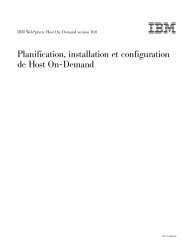Pianificazione, installazione e configurazione di Host On-Demand
Pianificazione, installazione e configurazione di Host On-Demand
Pianificazione, installazione e configurazione di Host On-Demand
You also want an ePaper? Increase the reach of your titles
YUMPU automatically turns print PDFs into web optimized ePapers that Google loves.
Supporto per Java 1 e Java 2<strong>Host</strong> <strong>On</strong>-<strong>Demand</strong> è compatibile con i browser che supportano gli standard Java 1 oJava 2. Inoltre, alcune nuove funzioni <strong>di</strong> <strong>Host</strong> <strong>On</strong>-<strong>Demand</strong> si avvalgono dellecapacità offerte solo da Java 2.Supporto per Internet Protocol Versione 6I seguenti sistemi operativi del server <strong>Host</strong> <strong>On</strong>-<strong>Demand</strong> supportano attualmenteInternet Protocol Versione 6 (IPv6):v Red Hat Linux 9.0 Personal e Professionalv Solaris V8 e V9v z/OS V1.5Il supporto per IPv6 richiede Java 1.4 o una versione superiore.Un IP (Internet Protocol) è un protocollo utilizzato per instradare i dati dalla loroorigine alla loro destinazione tramite un’ambiente Internet. Un IP è uninterme<strong>di</strong>ario tra i livelli <strong>di</strong> protocollo più alti e la rete fisica.IPv6 è la sostituzione per Internet Protocol Versione 4 (IPv4). IPv6 spande ilnumero <strong>di</strong> in<strong>di</strong>rizzi IP <strong>di</strong>sponibili ed apporta miglioramenti all’instradamento ealla <strong>configurazione</strong> <strong>di</strong> rete. Sia IPv6 che IPv4 sono stati progettati da IETF (InternetEngineering Task Force).La maggior parte <strong>di</strong> Internet utilizza attualmente IPv4. Si prevede che entroqualche anno IPv6 sostituirà IPV4.Il server <strong>Host</strong> <strong>On</strong>-<strong>Demand</strong> supporta anche IPv6 per il Re<strong>di</strong>rector. Per ulterioriinformazioni, consultare “Supporto Re<strong>di</strong>rector per IPv6” a pagina 48.Supporto <strong>di</strong> molte lingue nazionali<strong>Host</strong> <strong>On</strong>-<strong>Demand</strong> è <strong>di</strong>sponibile in 23 lingue, comprese le lingue DBCS (double-bytecharacter set). Viene fornito anche il supporto per il simbolo della valuta europea eil supporto per la tastiera e per la code page per molte altre lingue, quali l’arabo,l’ebraico e il tailandese. Tutte le versioni sono <strong>di</strong>sponibili sullo stesso supporto ed èpossibile accedere contemporaneamente a più versioni.ConnessionisicureMe<strong>di</strong>ante l’utilizzo <strong>di</strong> TLS (Transport Layer Security) versione 1.0 e SSL (SecureSockets Layer) versione 3.0, <strong>Host</strong> <strong>On</strong>-<strong>Demand</strong> consente accesso protetto ai dati hostsu reti intranet, extranet e su Internet. Gli utenti <strong>di</strong> computer portatili possonoaccedere ad un sito Web protetto, ricevere autentica e stabilire una comunicazionecon un host aziendale protetto. Con il supporto <strong>di</strong> certificato client e server, <strong>Host</strong><strong>On</strong>-<strong>Demand</strong> può presentare un certificato <strong>di</strong>gitale (X.509, Versione 3) al serverTelnet - come ad esempio IBM Communications Server per Windows NT Versione6 o successive o IBM Communications Server per z/OS - per l’autentica.<strong>Host</strong> <strong>On</strong>-<strong>Demand</strong> può anche essere configurato per un utilizzo in ambienti cheincludono firewall. E’ necessario aprire le porte firewall per le funzioni definitenelle definizioni <strong>di</strong> sessione <strong>di</strong> <strong>Host</strong> <strong>On</strong>-<strong>Demand</strong>. Per ulteriori informazioni,consultare “Utilizzo <strong>di</strong> <strong>Host</strong> <strong>On</strong>-<strong>Demand</strong> con un firewall” a pagina 49.6 IBM WebSphere <strong>Host</strong> <strong>On</strong>-<strong>Demand</strong> Versione 10.0: <strong>Pianificazione</strong>, <strong>installazione</strong> e <strong>configurazione</strong> <strong>di</strong> <strong>Host</strong> <strong>On</strong>-<strong>Demand</strong>






